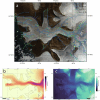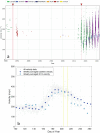Outburst of a subglacial flood from the surface of the Greenland Ice Sheet
- PMID: 40787653
- PMCID: PMC12331518
- DOI: 10.1038/s41561-025-01746-9
Outburst of a subglacial flood from the surface of the Greenland Ice Sheet
Abstract
As Earth's climate warms, surface melting of the Greenland Ice Sheet has intensified, increasing rates of sea-level rise. Observations and theory indicate that meltwater generated at the ice sheet surface can drain to its bed, where it flows relatively unhindered to the ocean. This understanding of water movement within and beneath ice sheets underpins the theoretical models that are used to make projections of ice sheet change. Here we present evidence of a destructive mode of meltwater drainage in Greenland. Using multiple satellite sources, we show that a 90-million-cubic-metre subglacial flood forced its way upwards from the bed, fracturing the ice sheet, and bursting through the surface. This phenomenon was triggered by the rapid drainage of a subglacial lake and occurred in a region where the ice bed was predicted to be frozen. The resulting flood caused a rapid deceleration of the downstream marine-terminating glacier. Our observations reveal a complex, bi-directional coupling between the ice sheet's surface and basal hydrological systems and demonstrate that extreme hydrological forcing may occur in regions of predicted cold-based ice. Such processes can impact the ice sheet's dynamics and structural integrity but are not currently considered in ice sheet models.
Keywords: Cryospheric science; Hydrology.
© The Author(s) 2025.
Conflict of interest statement
Competing interestsThe authors declare no competing interests.
Figures












References
-
- Otosaka, I. N. et al. Mass balance of the Greenland and Antarctic ice sheets from 1992 to 2020. Earth Syst. Sci. Data15, 1597–1616 (2023).
-
- Shepherd, A. et al. Mass balance of the Greenland Ice Sheet from 1992 to 2018. Nature579, 233–239 (2020). - PubMed
-
- Fox-Kemper, B. et al. in Climate Change 2021: The Physical Science Basis (eds Masson-Delmotte, V. et al.) 1211–1362 (Cambridge Univ. Press, 2021).
LinkOut - more resources
Full Text Sources
Research Materials
